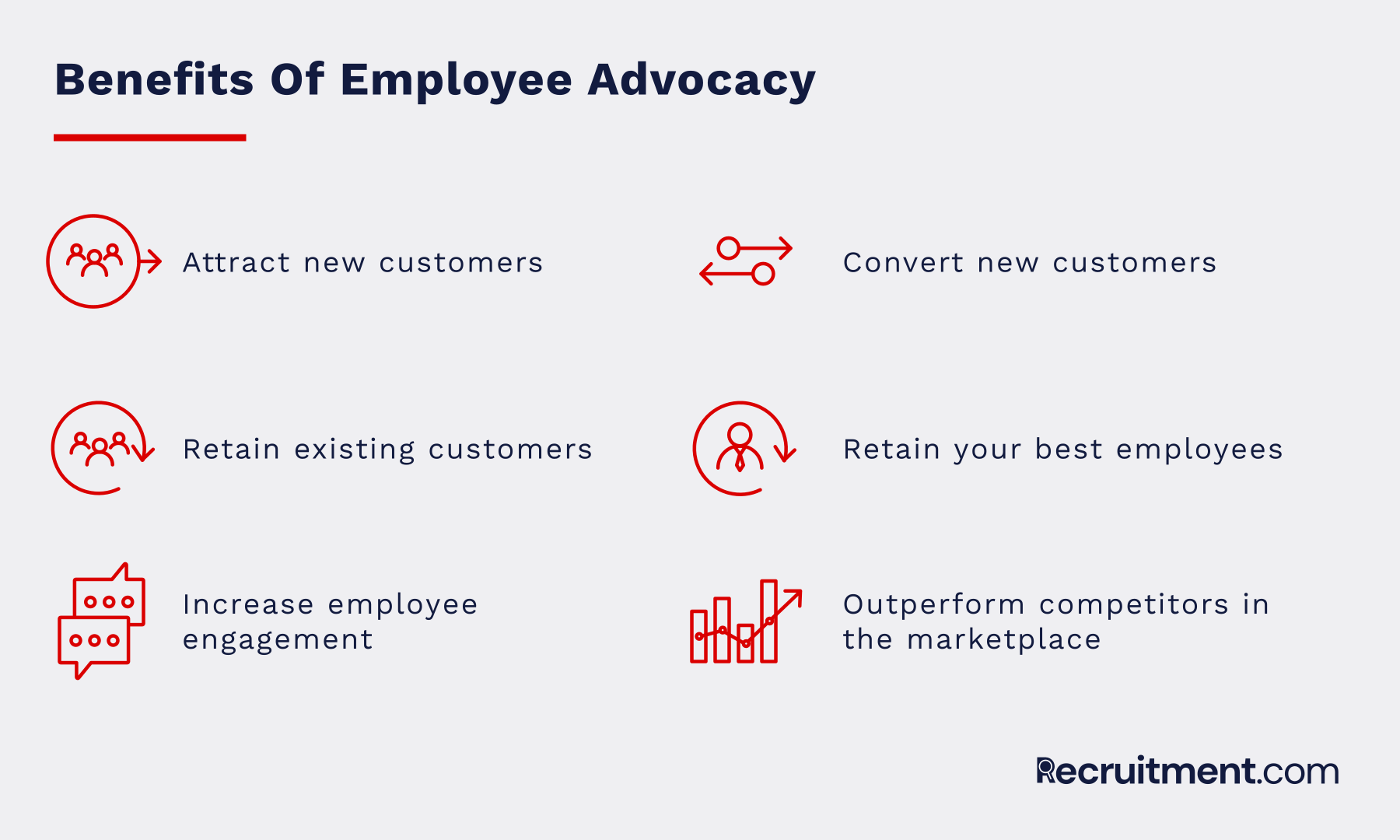Employee Advocacy 101: How To Set Up An Advocacy Program

Andrew McDermott is a business book author and writer whose work has been featured in Entrepreneur magazine and Fox Business.
Consistent employee advocacy is an achievable goal, provided that you have the right ingredients and a clear plan of action.
Research from Gallup's State of the Global Workplace shows that 63 percent of employees in the U.S. and Canada are not engaged at work. As you will soon see, this lack of engagement makes employee advocacy an unlikely proposition.
What is employee advocacy?
Employee advocacy is employee-led, company promotion. An employee advocate is a staff member who:
- Recruits other A-player employees to your organization
- Promotes your organization's products and services to people in their social circle
- Consistently acts in your organization's best interests
- Boosts company-wide employee engagement
- Becomes a thought leader, product, service, or subject-matter expert
Employee advocates are incredibly valuable. They have a significant impact on marketing, sales, and recruitment due to their reach. Here is why this is significant.
An international survey by FleishmanHillard Global Intelligence, found consumers are three times more likely to trust information about a company when it comes from the employee versus their CEO or an official channel. Research from the Edelman Trust Barometer agrees with these findings, showing that:
"A regular employee of a company is trusted by more than half (53%) of respondents when they are forming an opinion about a company. And the most trusted source about a company overall is one of its technical experts, as cited by 68% of respondents."
Customers trust individuals over the organization as a whole. A strong employee advocacy program means it is easier for your organization to:
- Attract new customers. When employees make recommendations to family, friends, and acquaintances in their social network, their personal credibility and trustworthiness are on the line. This is part of the reason why a personal recommendation carries so much weight.
- Convert new customers. Research from Nielsen found 83 percent of respondents in 60 countries say they trust the recommendations of friends and family, listing it as the most credible form of advertising among consumers.
- Retain existing customers. According to Dr. Paul Warner, Ph.D., there is a direct correlation between organizations that retain their best employees and those that retain their best customers. The more engaged your employees are, the better your team's customer service will be.
- Retain your best employees. Research from Facebook and the Harvard Business Review found employees leave their jobs when their work is no longer enjoyable, they are not using their strengths, and they are not growing or gaining the skills needed to further their careers. Who is responsible for their enjoyment? Your employees (managers).
- Increase employee engagement. When you give employees autonomy and a sense of ownership or buy-in, you increase engagement. These employees are more motivated to share their accomplishments and the impact they on their organization, increasing their advocacy. This fills employees with a sense of pride, which increases their engagement levels further.
- Outperform competitors in the marketplace. Established brands attract employees easily. Blue-chip brands like Apple, Google, Tesla, or Disney rely on their all-star talent to outperform their competitors. It is a strategy that smaller and medium organizations can use to great effect.
A strong employee advocacy program has a direct (or indirect) impact on almost every part of your organization. Your employer brand, revenue, sales and marketing campaigns, even your ability to compete in the marketplace. But all of it depends on your engagement
Great Employees Recruit Great Employees
A-players tend to attract T-shaped professionals, people with deep expertise in a specific area and broad, highly proficient knowledge.
This talent attraction builds a deep bench of experts rather than a shallow group of so-sos who are simply looking for a job.
The best way to solidify this boomerang effect in your organization is by empowering those great employees
When employee needs are met, they experience a deep sense of pride and fulfillment. They brag about their company. They become believers in the organization. Their satisfaction draws other great employees in. Here are some additional methods you can use to jump start employee advocacy.
- Give trustworthy employees more responsibility.
- Brag about your employee’s successes publicly.
- Provide employees advocates with consistent growth expectations.
- Give top performing employees opportunities to lead.
- Create incentive programs that reward employee innovation.
These strategies create an environment of advocacy. Each of these employees are far more likely to share the good news with anyone and everyone who will listen, attracting great employees naturally.

Why employee advocacy depends on engagement
Trust creates engagement, cementing the employer-employee partnership that is required to make advocacy programs work. Steve Rasmussen, the former CEO of Nationwide, understood the impact employee engagement had on his organization.
Working with Gallup, they made organization-wide changes to increase employee engagement. At the time, the ratio of engaged to actively disengaged employees was 2 to 1. By 2012, that ratio was 10 to 1.
How were they able to achieve such a dramatic and positive turnaround? By creating two employee segments:
- Patriots.
- Mercenaries.
Rasmussen observed that employees, in their jobs, are either patriots or mercenaries.
Patriots identify with their organization. They're true believers, aligned with their organization and its goals.
Mercenaries, on the other hand, are focused on personal outcomes - what's in it for me?
Patriots are engaged. Mercenaries may or may not be engaged. What do we mean by engagement? Here is how Gallup differentiates between the various types of employee engagement.
- Engaged employees: Are highly involved in and enthusiastic about their work and workplace. They are psychological "owners," drive performance and innovation and move the organization forward.
- Not engaged employees: Are psychologically unattached to their work and company. Because their engagement needs are not being met, they’re putting in time — but not energy or passion — into their work.
- Actively disengaged employees: Aren’t just unhappy at work — they are resentful that their needs aren’t being met and are acting out their unhappiness. Every day, these workers potentially undermine what their engaged coworkers accomplish.
Engagement, commitment, loyalty, and advocacy — these are all byproducts of trust. Engaged employees are more willing to advocate on their employer's behalf.
3 Employee Advocacy Strategies
The strategies for employee engagement are simple and uncomplicated.
- Increase employee engagement
- Recruit employees who are a culture-fit
- Act with authenticity
Here is a brief breakdown of each of these strategies.
1. Increase employee engagement
In Magic: Five Keys to Unlock the Power of Employee Engagement, Paul Warner, Ph.D., describes employee engagement as follows:
"Employee engagement is an emotional state where we feel passionate, energetic, and committed toward our work. In turn, we fully invest our best selves — our hearts, spirits, minds, and hands — in the work we do."
In his book, he outlines the five ingredients of employee engagement.
- Meaning is in the eye of the beholder. There are a variety of details that give employees a sense of meaning and purpose. As people, we are driven by six basic needs. Meeting these needs provides your employees with the meaning and purpose they are seeking.
- Autonomy refers to the freedom and control employees have while at work. Employees can have autonomy over their time, role, training, rights or privileges. This implicit admission of trust creates ownership, stimulates passion and excitement, and increases motivation.
- Growth: According to LinkedIn's 2019 Workforce Learning Report, 94 percent of employees say they would stay at a company longer if it invested in their learning and development. Growth opportunities further increase employee drive and purpose and reduce their stress levels. The most obvious point? Growth opportunities increase your employee's earning potential and advancement.
- Impact is about outcomes and results. When employees achieve small wins or see that their work leads to positive results, they are willing to work harder. Impact leads to increased engagement and large increases in productivity. The greater the impact, the greater an employee's drive to produce.
- Connection: A 2013 survey by Lifeboat found the average American only had one real friend. Employees today live in the age of loneliness. It's terrible for employees, and it's terrible for organizations. Loneliness decreases cognitive performance and immune health. Connected employees increase employee retention across the board.
Provide employees with each of these, and you have the tools you need to increase engagement on demand.

2. Recruit employees who are a culture-fit
Recruiting employees does not have to be a complicated or difficult ordeal. There is a simple and uncomplicated method you can use to recruit highly engaged, all-star employees. Are you ready for it?
Always be recruiting.
At first glance, this advice seems vague, generic, and unhelpful. Obviously you should be recruiting employees regularly. This is the kind of advice you hear from a variety of experts. What they don't tell you is how to go about doing that. Bradford Smart, Ph.D., creator of Topgrading, provides simple ideas you can use to recruit all-stars.
First, you create a virtual bench.
Your virtual bench is simply a pool of A-player candidates, employees-in-waiting. Relying on employee advocates is an effective strategy because the results compound over time. Your employees attract what they are. Your A-player employees, with (and sometimes without) incentives from you, will attract other A-players. High achievers prefer to spend their time with likeminded people. That is why it is crucial to attract A-players from the very start. Not only is it profitable, it sets your virtual bench up for immediate success.
Creating a virtual bench is beneficial for several reasons.
- The virtual bench is passive. Your organization always has a pool of outstanding candidates to choose from, at little or no cost.
- When an opening is created, HR can choose from pre-screened employees who have gone through most of the hiring steps.
- You can find and hire A-players who are cheaper and better than "proven" candidates who have years of experience.
Your virtual bench is built from existing employees. Top performers spend time with other top performers. How do you motivate your existing employees to stay in touch with their A-player friends? You incentivize them!
Here are two methods Dr. Smart recommends.
- Offer financial rewards. If a referred employee is still an employee after six months, you reward both the referred and referee with $1,000. This is a bargain as the average cost to hire a new employee is $4,129.
- Ask newly promoted managers to take an hour and list A-player subordinates in their most recent two jobs.
- Hire for potential, rather than current competence. Fill your virtual bench with potentials who are a value and culture-fit. You can train competence; it's much harder to address a culture mismatch.
- Acqui-hire. Hire A-players with A-players in their virtual bench. This requires that you confirm that you are indeed hiring an A-player.
These strategies ensure you attract employee patriots who are eager and willing to be part of your employee advocacy program. But what motivates employees to advocate on your behalf in the first place?
3. Act with authenticity
Companies do not display authenticity. The people in those companies--they display authenticity, which then defines the company.
Authenticity is synonymous with trustworthiness. According to Edelman, trusted employers are leaders, especially when it comes to change. The top five communication topics that are most effective in increasing employer trust are:
- Purpose: The organization's mission and purpose in the marketplace.
- Operations: Including company decisions that affect employee wellbeing.
- Values: How do values drive the organization and define corporate culture.
- The future: What is the organization's vision for the future?
- Societal impact: What are the organization's contributions to the betterment of society.
Organizations that meet these employee expectations build strong trust. This trust produces the employee advocacy, loyalty, engagement, and commitment we talked about earlier.
Implementing an employee advocacy program
Here are several key steps you can take to implement an employee advocacy program. You will want to spend the upfront time required to plan your advocacy program.
1. Define your goals and KPIs
You will want to define your expectations ahead of time. Your goals should be specific, measurable, and well defined. Your goals and KPIs should be shared with the entire organization to create realistic expectations for everyone to follow. Here is a sample list of goals and KPIs you can use to set up your advocacy program.
- Consistent employee recruitment and retention. A high value, low cost source for qualified candidates and employees.
- More A-player applicants. Maintain a virtual bench that's consistently full of A-player candidates who were referred by existing A-player employees.
- Increase employee engagement. Increasing engagement increases advocacy. A strong employee advocacy program increases engagement.
- Increase website traffic: Qualified traffic comes in on specific landing pages. (e.g., product, service, or HR-related pages)
- Employer branding. A strong brand is synonymous with a strong reputation. Good employer branding produces a 50 percent increase in qualified candidates, a 50 percent cost-to-hire reduction, and 1-2x faster time-to-hire.
- Extend your brand reach. Advocacy programs give you access to an employee's social network. The more employees in your organization's advocacy program the more potential for people to hear about your organization.
- Lead generation, sales, or revenue. Direct response marketing results derived from employee advocacy and employee social media marketing.
- Increased referrals. A consistent flow of leads (sales, hiring, or partnerships) from employee referrals to friends and family.
- Employee thought leadership: Employees stepping into the role of a thought leader or subject matter expert.
Additional KPIs include:
- Average shares per employee.
- Proportion of web traffic from employee-sparked efforts.
- Average pieces of content read by employees
- Exposure to new audiences.
- Direct traffic.
You'll want to define your goals and KPIs clearly and accurately, so you can measure success.
2. Identify your employee advocates
Who are your ideal employee advocates?
You are looking for patriots — highly engaged A-player employees who trust and admire your business. These employees are highly productive and focused on producing value. They are easy to find if you optimize your business around productivity.
Use Price's law to identify top performers.
Derek de Solla Price, noted information scientist and physicist, made a discovery. He discovered a mathematical formula that demonstrates:
- Value creation is asymmetrical and
- Incompetence is exponential; competence is linear
What is his formula?
The square root of the number of people in a domain does 50 percent of the work.
- If there are 100 people in your company, 10 of them do half the work
- Ten developers on your team? Three of them do half the work
Why pursue these employees? These highly productive all-stars chose to be "square roots," employees who are focused on producing extraordinary value for your organization. Approach these employees first and ask them to help you build your advocacy program.
3. Outline your content & social media strategy
Communication is the lifeblood of advocacy. You will need to plan and outline the content you will create. The reason? Your employees will need a message to share. It is a good idea to create an editorial calendar and content distribution plan.
What motivates employee advocates to share employer content?
The New York Times Customer Insight Group conducted a study titled "The Psychology of Sharing." They wanted to identify the drivers that motivate people to share content online. The study outlined six types of online sharers.
- Altruists are helpful, thoughtful, reliable, and connected. They curate content on behalf of friends and family in their social network.
- Careerists are highly intelligent sharers who rely on social media platforms like LinkedIn and Facebook to build professional relationships.
- Hipsters are young, creative, popular, and less likely to email. Sharing is a part of their identity. It is simply what they do.
- Boomerangs focus their attention on reactions. They share content as a form of validation. These sharers use questions to stimulate comments and debate with others. If they do not get a reaction, they have missed the mark.
- Connectors are listed in the study as creative, thoughtful, and relaxed. These sharers make plans via phone, email, and social media. They mix freebies and discounts, focusing their attention on specific goals (i.e., saving money).
- Selectives share content with specific people if they believe those people will enjoy it. If the content is not relevant to them, these advocates won't share.
The type of sharer defines the type of content you should create for each of the six content types. The key to successful content sharing is relevance. Use these content types to create content that is relevant for your employees and the people they will be sharing it with.
Social media enables you to harness your employee's social networks. In addition to the types of sharers above, Wharton professor Jonah Berger et al. identified six characteristics of highly shareable content on social media. Successful social sharing content has the following traits.
- Social currency: Employees are more likely to share content that increases their social currency.
- Top of mind: Trending content or content that's focused on a particular topic or subject.
- Emotion: Content that stokes specific emotions performs well, especially if it is relevant and focused on your employees and their audience.
- Publicity: Content that attracts or generates a significant amount of publicity. Employees and people in their networks are more likely to share what their colleagues are sharing.
- Practical value: Useful content of a practical nature is highly shareable.
- Stories: Thought leadership via storytelling that's easy to share, relevant and appropriate for others
It cannot be genuine if you tell employee advocates what to share. Everyone Social explains the need for genuineness.
"The fact is that social media is an organic process. If you tell employees what to share, they’ll instantly feel turned off. The desire to share must come from within – however, your company does need to take steps to ensure that team members have enough direction."
4. Train employee advocates
Your employee advocates will need training. Many employees will be unfamiliar with the ins and outs of personal branding. Your organization will need to show them how to align with your employer branding, manage personal branding, etc.
Here is a shortlist of the training and resources you'll need for your employee advocacy program.
- Create a company-wide policy that outlines the standards and specifications for employee sharing.
- Show employee advocates when it is okay to share and how to do it successfully.
- Training on personal branding, what to expect, becoming an expert, shaping perceptions, etc.
- Conducting training sessions regularly to ensure employee advocates are prepared and comfortable.
- Discuss employee benefits (What's in it for me?) with advocates.
- The goals and KPIs you want your employee advocates to focus on.
- Incentivizing participation and providing coaching.
- Create a review response strategy for employee reviews.
The more training you provide your employee advocates, the easier it is to give them the autonomy they need to achieve amazing results.
Conclusion: Your Employee Advocacy Needs To Be Genuine
With the right framework, employees can share your content organically, whether it is in-person, via social media, through email, or on the phone. How will you gauge the effectiveness of your offline efforts? By sending employees to specific landing pages on your website and using UTM parameters in Google analytics.
Can you control these channels or employee advocacy programs in general?
Not really, no.
This is why it is so important that you focus your time and attention on finding the right employees ahead of time. The more you attempt to regulate advocacy, the less genuine and the less effective it is. Employees need a certain degree of autonomy if advocacy is going to work.
Trust is part of the advocacy process.
Start with trust.
Increase employee engagement, recruit employees who are a culture and value fit, and act with authenticity. Follow the steps we have covered today, and you'll have the beginnings of a successful advocacy program, no disengagement necessary.
What about you? How do you get your employees to advocate on your behalf?

Andrew McDermott is a business book author and writer whose work has been featured in Entrepreneur magazine and Fox Business.






